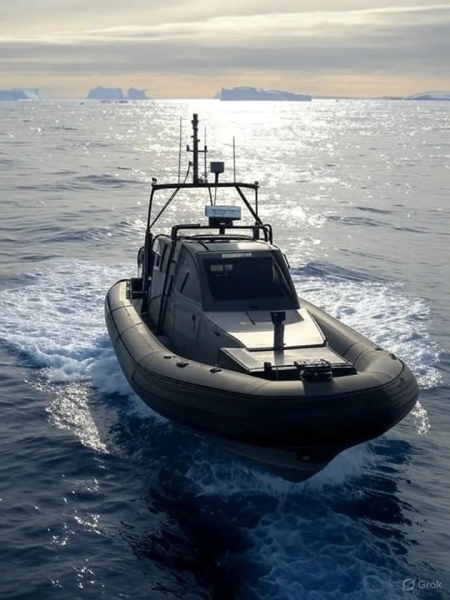Eric Schmidt’s Foundation Deploys Autonomous Drone Boats To Antarctic Waters For Climate Research

DJI Mavic 4 Pro with DJI RC 2 for $2,819 on Amazon!
Former Google CEO Eric Schmidt’s foundation is committing $45 million to deploy autonomous drone boats into the treacherous waters surrounding Antarctica, marking a significant investment in climate science technology. The Schmidt Sciences initiative will send uncrewed surface vessels into the Southern Ocean to gather critical data on carbon absorption and climate dynamics in conditions too extreme for traditional research ships.
The drone boats represent a breakthrough approach to studying one of Earth’s most important but least understood climate systems. The Southern Ocean absorbs up to 40% of human-emitted CO2, making it a crucial carbon sink whose behavior could determine the pace of global climate change.
Why This Matters For Drone Technology
This project demonstrates how autonomous drone systems are expanding beyond commercial and military applications into environmental science. The extreme conditions of Antarctic waters—punishing waves, sub-zero temperatures, and months-long isolation—require the kind of resilient, AI-driven autonomy that pushes the boundaries of current drone capabilities.
For drone professionals, this represents a proving ground for technologies that could reshape scientific research, environmental monitoring, and operations in hostile environments worldwide.
Southern Ocean Carbon Research Mission
The autonomous drone boats will be deployed through the COCO2 project (Constraining Ocean Carbon with Optimized Observing), one of four research teams receiving funding from Schmidt Sciences’ Virtual Institute for the Carbon Cycle.
According to project details, the drones will navigate areas too dangerous for traditional research vessels, collecting real-time measurements of ocean currents, water temperature, and carbon dioxide absorption. This data will help scientists refine global climate models and better understand how warming oceans affect the planet’s natural carbon buffers.
The Southern Ocean occupies a quarter of the global ocean surface but plays an outsized role in regulating Earth’s climate systems, absorbing an estimated 40% of anthropogenic carbon emissions and nearly 75% of excess atmospheric heat annually.
Advanced Autonomous Navigation Systems
The drone boats will employ AI-driven navigation systems designed to operate for extended periods without human intervention. These uncrewed vessels must withstand extreme conditions while autonomously evading ice floes and gathering subsurface data.
Engineers have equipped the drones with cold-resistant batteries, satellite and acoustic communications systems, and advanced sensors capable of continuous data collection. The vessels will need to operate where traditional ships cannot go, filling critical gaps in our understanding of how Antarctic waters sequester atmospheric carbon.
This technology mirrors innovations in other autonomous maritime systems, but the Antarctic application demands unprecedented resilience and self-sufficiency.
$45 Million Carbon Cycle Research Initiative
Schmidt Sciences, the foundation created by Eric and Wendy Schmidt, will spend $45 million over five years on carbon cycle research projects. The Antarctic drone boat initiative is part of this broader effort to advance understanding of the global carbon cycle.
“We are just starting to understand the true extent of humankind’s effect on the intricately woven systems of land, sea and air,” said Wendy Schmidt, co-founder of Schmidt Sciences. “The Virtual Institute for the Carbon Cycle will offer us not only clarity but also the information we need to make wise decisions along the way toward a healthier, more resilient and more secure world and future for all.”
The funding supports four research teams using cutting-edge technology—including drones, satellites, and AI—to study carbon cycling across land, ocean, and atmosphere. The Antarctic project addresses one of the most challenging environments on Earth.
Regulatory And Environmental Considerations
Deploying autonomous systems in Antarctic waters requires regulatory approval from Antarctic Treaty nations and careful consideration of environmental impact. The drones must operate within international frameworks governing scientific research in protected polar regions.
Scientists and engineers must also address the environmental footprint of manufacturing and deploying these devices, balancing the research benefits against any potential ecosystem disturbance in one of Earth’s most pristine environments.
The project builds on the Schmidt family’s existing Antarctic research support through the Schmidt Ocean Institute, which operates the research vessel R/V Falkor (too) for polar expeditions.
DroneXL’s Take
The deployment of autonomous drone boats in Antarctic waters represents a pivotal moment for drone technology serving environmental science. We’ve covered numerous underwater and surface drones—from DARPA’s Manta Ray to Ukraine’s naval systems—but this project shows how the same autonomous capabilities developed for defense and commercial applications can tackle humanity’s most pressing scientific challenges.
The Southern Ocean project is particularly significant because it demonstrates drone technology‘s ability to operate in conditions that would be impossible or prohibitively expensive with traditional methods. When research vessels cost millions to deploy and can’t access the most critical areas, autonomous drones offer a scalable, cost-effective solution.
What makes this especially relevant for our readers is how innovations tested in extreme Antarctic conditions often trickle down to commercial and recreational drone technology. The cold-resistant batteries, advanced AI navigation, and resilient communications systems developed for these scientific missions could eventually enhance civilian drone capabilities worldwide.
The $45 million investment also signals growing recognition that autonomous systems are essential for climate research. As the planet changes, understanding carbon cycle dynamics becomes increasingly urgent—and drones may be our best tool for gathering the data we need.
What do you think? Share your thoughts in the comments below.
